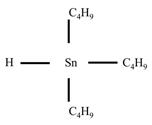TBT
Contents
Definition of tributyltin:
Tributyltin (TBT). Antifouling paint for ships hulls which is toxic to marine life and prohibited by some nations for use on small craft.
[1]
This is the common definition for tributyltin, other definitions can be discussed in the article
|
Notes
| Tributyltin |
|---|

|
| Formula |
| C12H28Sn |
Antifouling paints containing TBT are much more effective and long lasting than mercury or copper based antifouling paints. They were first painted on ships in the 1970s and were subsequently also commonly used net enclosures of mariculture installations.[2]
TBT concentrations ranged from 1 ng/l in boat free areas to levels above 600 ng/l near marinas. Levels above 1 µg/l can be reached in heavily polluted marinas. Such concentrations which are toxic for mollusk larvae, have caused recruitment failure of scallops and oysters in the affected areas. TBT also causes a variety of sublethal effects at much lower levels. Concentrations of 10 ng/l can cause reduced growth and shell thickening in oysters, which reduces the size of the animals inside, making the oysters unmarketable. Another sublethal effect of TBT is the development of an nonfunctional penis in females, a condition called imposex. The oviduct and the female genital opening are eventually overgrown by the developing penis and are blocked so that the eggs can not be laid. The affected populations decline and can eventually become locally extinct. Awareness of these effects resulted in an international ban to apply TBT on ships starting from 2003, and the obligation to remove all TBT on ships by 2008.[2]
Mammals, birds, crustatians and fish seem to be able to break down TBT. Therefore there is little or no risk for biomagnification of TBT.[3]
Case studies
TBT and intersex in periwinkles